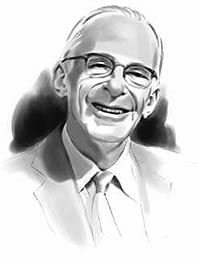
The Man Behind the Machine
Lyman Spitzer, Jr. (1914—1997), a world-renowned theoretical astrophysicist, developed the concept of a telescope in space. In 1946 — more than a decade before the launch of the first satellite — Spitzer proposed the development of a large, space-based observatory that would not be hindered by Earth's atmospheric distortion and span a broad range of wavelengths. This lofty vision ultimately became the Hubble Space Telescope.
Spitzer was instrumental in the design and development of the Hubble Space Telescope. Throughout the 1960s and 1970s, he was an enthusiastic lobbyist for the telescope, both with Congress and the scientific community. Even after Hubble's launch in 1990, Spitzer remained deeply involved in the program. Not only did he make some important astronomical observations with the telescope that was essentially his brainchild, but he also spent a great deal of time — right up until the end of his life — analyzing Hubble data.
In addition to space astronomy, Spitzer's work greatly advanced knowledge in other fields, including stellar dynamics, plasma physics, and thermonuclear fusion.
